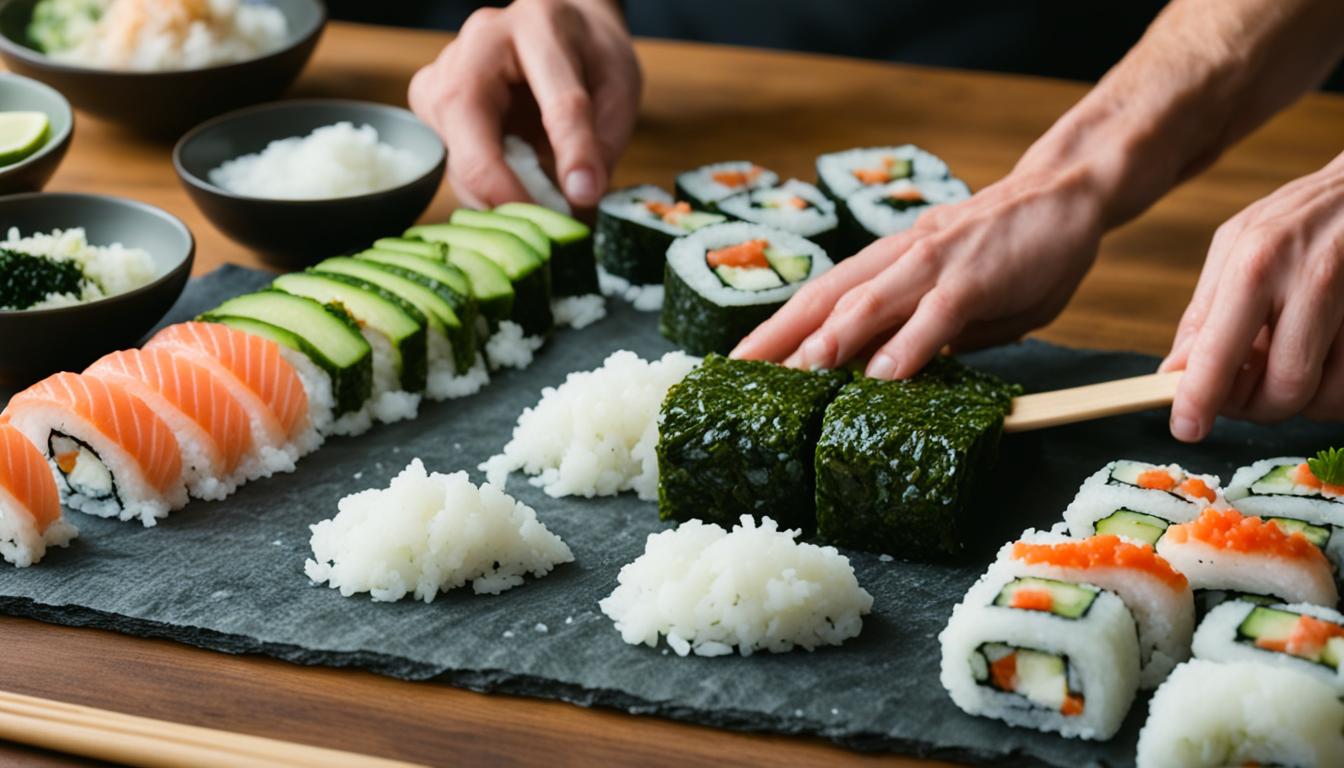Are you tired of spending a fortune on sushi delivery? Have you ever wondered how to make sushi at home, but thought it was too complicated? Prepare to be pleasantly surprised! Making your own homemade sushi is easier than you think and oh-so-satisfying. With a few essential techniques and our expert tips, you’ll be rolling out delicious sushi rolls in no time.
Whether you’re a sushi enthusiast or a beginner in the culinary world, this step-by-step guide will equip you with everything you need to know to create tantalizing homemade sushi. Say goodbye to mediocre takeout sushi, and say hello to the satisfaction of mastering the art of sushi making in the comfort of your own kitchen.
So, are you ready to embark on a delicious and fulfilling journey? Let’s dive into the fascinating world of homemade sushi!
Key Takeaways:
- Learn how to make sushi at home with our easy-to-follow guide
- Discover the essential techniques and tips for creating delicious homemade sushi
- Explore the key ingredients needed for sushi making and how to prepare the perfect sushi rice
- Master various sushi rolling techniques and get creative with your sushi presentations
- Enjoy the process of making homemade sushi and share your culinary creations with your loved ones
Top Ingredients and Sushi Rice Preparation
When it comes to making sushi at home, using high-quality ingredients and perfectly cooked sushi rice is key to achieving authentic flavors. In this section, we will explore the top ingredients you’ll need for delicious homemade sushi and provide detailed instructions on how to prepare the perfect sushi rice.
Essential Sushi Ingredients
Creating delectable sushi rolls starts with selecting the right ingredients. Here are the essential components for homemade sushi:
- Sushi Rice: The foundation of any sushi roll, sushi rice is short-grain rice seasoned with a mixture of rice vinegar, sugar, and salt. Its sticky texture allows the rice to hold its shape when rolled.
- Nori: Nori is a type of dried seaweed that wraps around sushi rolls. It adds a subtle umami flavor and provides a crisp texture.
- Sashimi-grade Fish: For sushi rolls with raw fish, it’s crucial to choose high-quality, fresh, and sashimi-grade fish. Popular options include tuna, salmon, yellowtail, and shrimp.
- Vegetables: Vegetables like cucumber, avocado, carrots, and bell peppers add crunch, color, and a refreshing taste to sushi rolls. They also provide an excellent option for vegetarian sushi.
- Other Fillings: Get creative with fillings like cream cheese, crab sticks, tofu, mango, and tempura for unique flavor combinations and textures.
- Soy Sauce and Wasabi: Soy sauce and wasabi are classic condiments served alongside sushi. Soy sauce adds savory notes, while wasabi provides a spicy kick.
Preparing Perfect Sushi Rice
Sushi rice preparation requires attention to detail to achieve the desired texture and flavor. Follow these simple steps:
- Rinse the rice: Wash the sushi rice under cold water until the water runs clear to remove excess starch.
- Cook the rice: Cook the rinsed rice with water in a rice cooker or on the stovetop according to the package instructions.
- Season the rice: In a small saucepan, mix rice vinegar, sugar, and salt. Heat the mixture over low heat until the sugar dissolves.
- Combine the rice and seasoning: Once the rice is cooked, transfer it to a large bowl. Gradually pour the seasoned vinegar mixture over the rice while gently folding it in with a wooden spatula.
- Cool the rice: Allow the seasoned rice to cool to room temperature before using it to make sushi rolls. Cooling the rice prevents it from becoming mushy.
By following these steps, you’ll have perfectly cooked sushi rice with a subtle tangy taste that complements the other ingredients in your sushi rolls.
| Sushi Ingredients | Description | Image |
|---|---|---|
| Sushi Rice | Short-grain rice seasoned with rice vinegar, sugar, and salt. | |
| Nori | Dried seaweed sheets that wrap around sushi rolls. |  |
| Sashimi-grade Fish | High-quality, fresh fish specifically meant for raw consumption. |  |
| Vegetables | Cucumber, avocado, carrots, bell peppers, etc., adding crunch and flavor. | |
| Other Fillings | Cream cheese, crab sticks, tofu, mango, tempura, etc., for unique flavors. |
Now that you have a solid understanding of the essential sushi ingredients and how to prepare perfect sushi rice, you’re ready to move on to the next section and explore various sushi rolling techniques and serving suggestions.
Sushi Rolling Techniques and Serving Suggestions
Now that you have mastered the art of sushi rice preparation, it’s time to move on to the fun part: rolling sushi! Whether you prefer the traditional maki rolls or want to try out trendy sushi burritos, we’ve got you covered with a variety of sushi rolling techniques to take your homemade sushi to the next level.
Before you start rolling, here are some essential tips to keep in mind:
- Make sure your hands are slightly wet to prevent the rice from sticking to your fingers.
- Use a sharp knife to cut your sushi rolls for clean and beautiful slices.
- Experiment with different fillings and combinations to create unique sushi flavors.
- Don’t be afraid to get creative and try new techniques to personalize your sushi rolls.
Now let’s explore some popular sushi rolling techniques:
1. Maki Rolls
Maki rolls are the classic sushi rolls that most people are familiar with. They consist of nori (seaweed) wrapped around sushi rice and fillings.
To make a maki roll:
- Place a sheet of nori on a bamboo sushi mat.
- Spread a thin layer of sushi rice over the nori, leaving a small border at the top.
- Add your desired fillings (such as fresh fish, vegetables, or tempura) in a line across the center of the rice.
- Use the sushi mat to roll the nori tightly, applying gentle pressure as you roll.
- Moisten the edge of the nori with water to seal the roll.
- Slice the roll into bite-sized pieces using a sharp knife.
2. Inside-Out Rolls
Inside-out rolls, also known as uramaki, are rolls with the nori on the inside and the rice on the outside. This style of sushi is perfect for experimenting with different toppings and presentations.
To make an inside-out roll:
- Place a sheet of plastic wrap on a bamboo sushi mat.
- Place a sheet of nori on top of the plastic wrap.
- Spread a thin layer of sushi rice over the nori, covering it completely.
- Turn the nori and rice sheet over, so the rice is facing down on the mat.
- Add your desired fillings in a line across the center of the nori.
- Use the sushi mat to roll the sushi tightly, applying gentle pressure as you roll.
- Remove the plastic wrap and place the roll on a clean surface.
- Add your preferred toppings (such as sesame seeds or sliced avocado) to the exposed rice.
- Slice the roll into bite-sized pieces.
Serving Suggestions for Your Homemade Sushi
“Presentation is key when it comes to sushi. Elevate your homemade sushi experience with these serving suggestions.”
– Sushi Master Hiroshi Tanaka
Serving your homemade sushi like a pro can make a big difference in the overall dining experience. Here are a few serving suggestions to make your sushi look irresistible:
- Arrange the sushi rolls on a beautiful platter or wooden sushi board.
- Garnish the platter with pickled ginger, wasabi, and soy sauce for dipping.
- Add a sprinkle of sesame seeds or chopped scallions on top of your sushi rolls for an extra pop of flavor and visual appeal.
- Serve the sushi rolls with a side of miso soup or a fresh salad for a complete meal.
No matter which sushi rolling technique you choose, remember to have fun and enjoy the process. With practice and creativity, you’ll soon be rolling out sushi masterpieces that rival those of your favorite sushi restaurant.
Conclusion
Creating homemade sushi is a rewarding and enjoyable culinary experience that anyone can master. By following our step-by-step guide and incorporating these valuable sushi making tips, you can effortlessly prepare restaurant-quality sushi in the comfort of your own kitchen.
One of the great advantages of making sushi at home is the ability to personalize your rolls with a wide variety of flavors and ingredients. Don’t be afraid to experiment and get creative! Whether you prefer classic fillings like fresh seafood or want to try unique combinations like avocado and mango, the choice is yours.
Remember, making sushi is not just about the end result; it’s also about the process. Gather your family or friends and turn sushi-making into a fun and interactive activity. Enjoy exploring different techniques, such as traditional maki rolls or trendy sushi burritos, and let your imagination run wild.
So, why wait? Start your homemade sushi adventure today and impress your loved ones with your newfound skills. With easy sushi recipes and our expert guidelines, you’ll soon be rolling sushi like a pro. From the first bite to the last, savor the satisfaction of creating delicious homemade sushi that will delight your taste buds.
FAQ
How do I make sushi at home?
To make sushi at home, you’ll need sushi rice, nori (seaweed sheets), fresh fish or vegetables, and a bamboo sushi mat. Start by preparing the sushi rice according to the instructions. Then, place a sheet of nori on the sushi mat, spread a layer of rice on top, and add your desired fillings. Roll the sushi tightly using the mat, cut into bite-sized pieces, and serve with soy sauce and wasabi.
What are the essential ingredients for sushi?
The essential ingredients for sushi include sushi rice, nori (seaweed sheets), fresh fish or vegetables, soy sauce, wasabi, and pickled ginger. You can also add toppings like sesame seeds or tobiko (fish roe) for added flavor and texture.
How do I prepare the perfect sushi rice?
To prepare the perfect sushi rice, rinse the rice thoroughly to remove excess starch. Cook the rice in a rice cooker or on the stovetop with the appropriate amount of water. Once cooked, transfer the rice to a wooden or non-metallic bowl, and gently toss it with sushi vinegar. Allow the rice to cool slightly before using it to make sushi rolls.
What are some sushi rolling techniques I can try at home?
There are various sushi rolling techniques you can try at home. For traditional maki rolls, place a sheet of nori on the sushi mat, add a layer of sushi rice, and place fillings like fish, vegetables, or tempura in the center. Roll the sushi tightly using the mat and slice into pieces. You can also experiment with trendy sushi burritos, where you place fillings in the center of a large sheet of nori, roll it tightly, and slice it into bite-sized pieces.
Any serving suggestions or tips for presenting homemade sushi?
When serving homemade sushi, you can garnish the plate with pickled ginger and wasabi for extra flavor. Arrange the sushi rolls on a platter and sprinkle them with sesame seeds or tobiko for a pop of color. You can also serve the sushi with a soy sauce dipping dish and small dishes of wasabi and pickled ginger on the side. Don’t forget to present your sushi rolls in an appealing and artistic manner for a professional touch.


